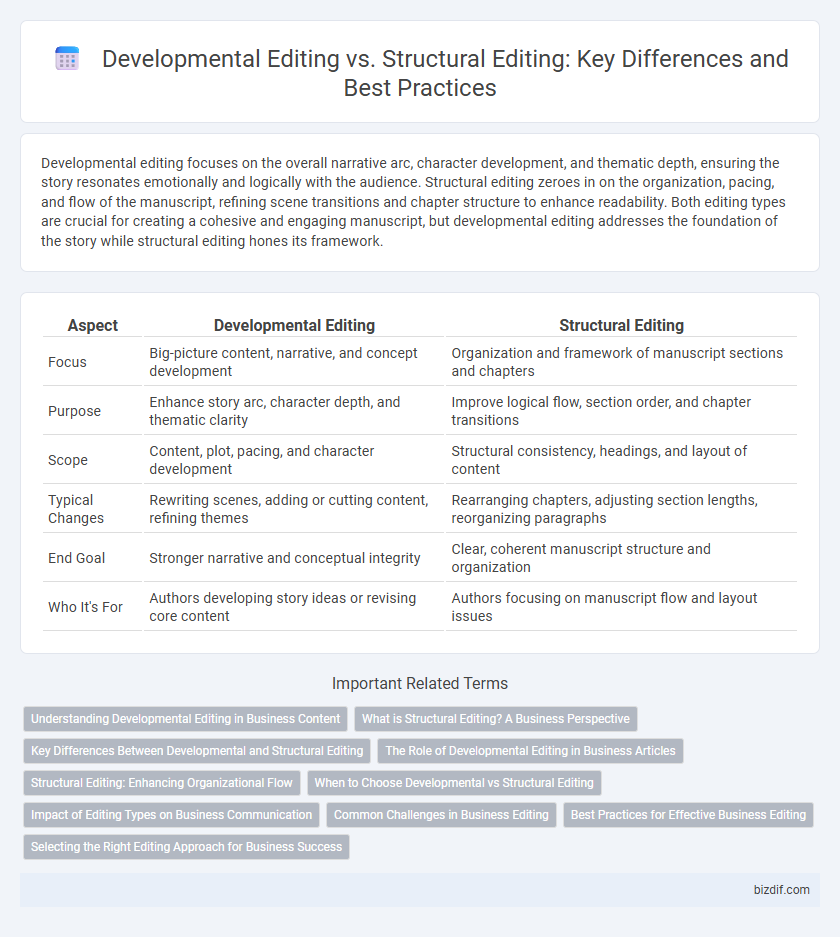Developmental editing focuses on the overall narrative arc, character development, and thematic depth, ensuring the story resonates emotionally and logically with the audience. Structural editing zeroes in on the organization, pacing, and flow of the manuscript, refining scene transitions and chapter structure to enhance readability. Both editing types are crucial for creating a cohesive and engaging manuscript, but developmental editing addresses the foundation of the story while structural editing hones its framework.
Table of Comparison
| Aspect | Developmental Editing | Structural Editing |
|---|---|---|
| Focus | Big-picture content, narrative, and concept development | Organization and framework of manuscript sections and chapters |
| Purpose | Enhance story arc, character depth, and thematic clarity | Improve logical flow, section order, and chapter transitions |
| Scope | Content, plot, pacing, and character development | Structural consistency, headings, and layout of content |
| Typical Changes | Rewriting scenes, adding or cutting content, refining themes | Rearranging chapters, adjusting section lengths, reorganizing paragraphs |
| End Goal | Stronger narrative and conceptual integrity | Clear, coherent manuscript structure and organization |
| Who It's For | Authors developing story ideas or revising core content | Authors focusing on manuscript flow and layout issues |
Understanding Developmental Editing in Business Content
Developmental editing in business content focuses on shaping the overall message, organization, and flow to align with strategic goals and target audiences. This process enhances clarity, coherence, and persuasive impact by addressing content gaps, tone, and key messaging before fine-tuning the text. Unlike structural editing, which zeroes in on paragraph and sentence grammar, developmental editing ensures the content effectively drives business objectives and engages stakeholders.
What is Structural Editing? A Business Perspective
Structural editing, from a business perspective, involves analyzing and reorganizing the content framework to enhance clarity, flow, and impact, ensuring the overall narrative aligns with market demands and brand messaging. This type of editing addresses chapter arrangement, pacing, and logical progression to optimize reader engagement and drive commercial success. By focusing on the macro-level structure, structural editing helps businesses deliver a coherent product that meets strategic goals and audience expectations.
Key Differences Between Developmental and Structural Editing
Developmental editing focuses on the overall content, narrative arc, and character development, addressing big-picture elements like plot consistency and thematic depth. Structural editing, on the other hand, concentrates on the organization and flow of the manuscript, ensuring that chapters and scenes are arranged logically and transitions are smooth. Key differences include developmental editing's emphasis on content quality and storytelling, while structural editing targets the framework and coherence of the text.
The Role of Developmental Editing in Business Articles
Developmental editing in business articles focuses on refining content to enhance clarity, coherence, and overall message alignment with target audiences. It addresses the article's purpose, organizing ideas logically and ensuring the narrative supports business objectives effectively. Structural editing, by contrast, emphasizes the framework and flow of the article, ensuring sections and paragraphs are well-ordered and transitions are smooth.
Structural Editing: Enhancing Organizational Flow
Structural editing improves the manuscript's organizational flow by focusing on the arrangement of scenes, chapters, and overall plot coherence. This process ensures that pacing, narrative consistency, and logical progression effectively engage readers and support the author's thematic goals. Prioritizing structural editing leads to a clearer, more compelling story that strengthens the foundation before fine-tuning language and style.
When to Choose Developmental vs Structural Editing
Developmental editing is ideal during the early stages of a manuscript when authors need guidance on plot, character development, and overall narrative structure to shape the story's foundation. Structural editing is best suited for later stages, focusing on refining chapter order, pacing, and scene transitions to enhance readability and coherence. Selecting developmental editing is crucial when the manuscript requires significant conceptual changes, while structural editing is chosen to polish and streamline the existing framework.
Impact of Editing Types on Business Communication
Developmental editing enhances business communication by refining overall message clarity, coherence, and audience alignment, ensuring content purpose drives reader engagement. Structural editing focuses on organizing information logically and efficiently, improving the flow and accessibility of business documents to facilitate decision-making processes. Both editing types significantly impact the effectiveness of business communication by addressing different layers of content quality and readability.
Common Challenges in Business Editing
Developmental editing and structural editing both address the organization and content flow but commonly face challenges such as maintaining clarity and coherence across complex business documents. Business editing often involves aligning diverse stakeholder perspectives while ensuring the core message supports strategic objectives. Editors must balance thorough content refinement with deadlines, preserving the document's intent and tone to meet professional standards.
Best Practices for Effective Business Editing
Developmental editing focuses on the overall content, theme, and narrative arc, ensuring alignment with business objectives and target audience needs, while structural editing refines the organization, flow, and clarity of the document at the paragraph and sentence levels. Best practices for effective business editing include clear goal-setting, consistent style adherence, and iterative reviews incorporating stakeholder feedback to enhance coherence and impact. Leveraging detailed developmental edits before structural adjustments maximizes content relevance and communication efficiency in business documents.
Selecting the Right Editing Approach for Business Success
Selecting the right editing approach is crucial for business success, with developmental editing focusing on overarching content, narrative structure, and character development, while structural editing hones in on organization, flow, and consistency within chapters or sections. Developmental editing enhances the core message and market alignment, ensuring the product resonates with target audiences, whereas structural editing improves readability and coherence, maximizing user engagement and retention. Understanding these distinctions allows businesses to invest in tailored editing strategies that optimize content quality and drive competitive advantage.
Developmental editing vs Structural editing Infographic

 bizdif.com
bizdif.com